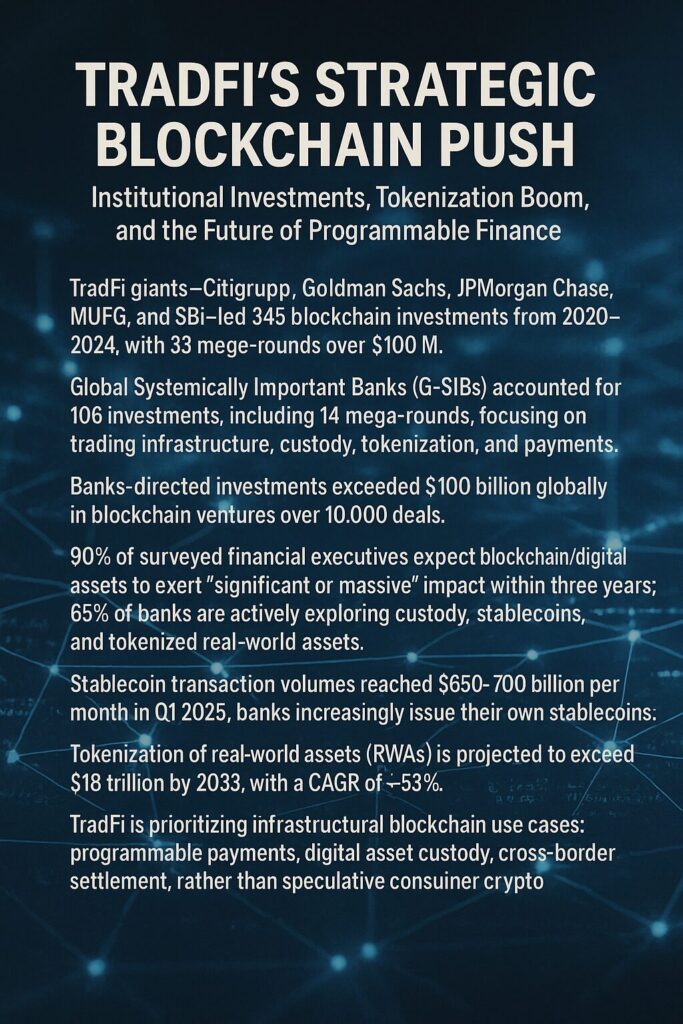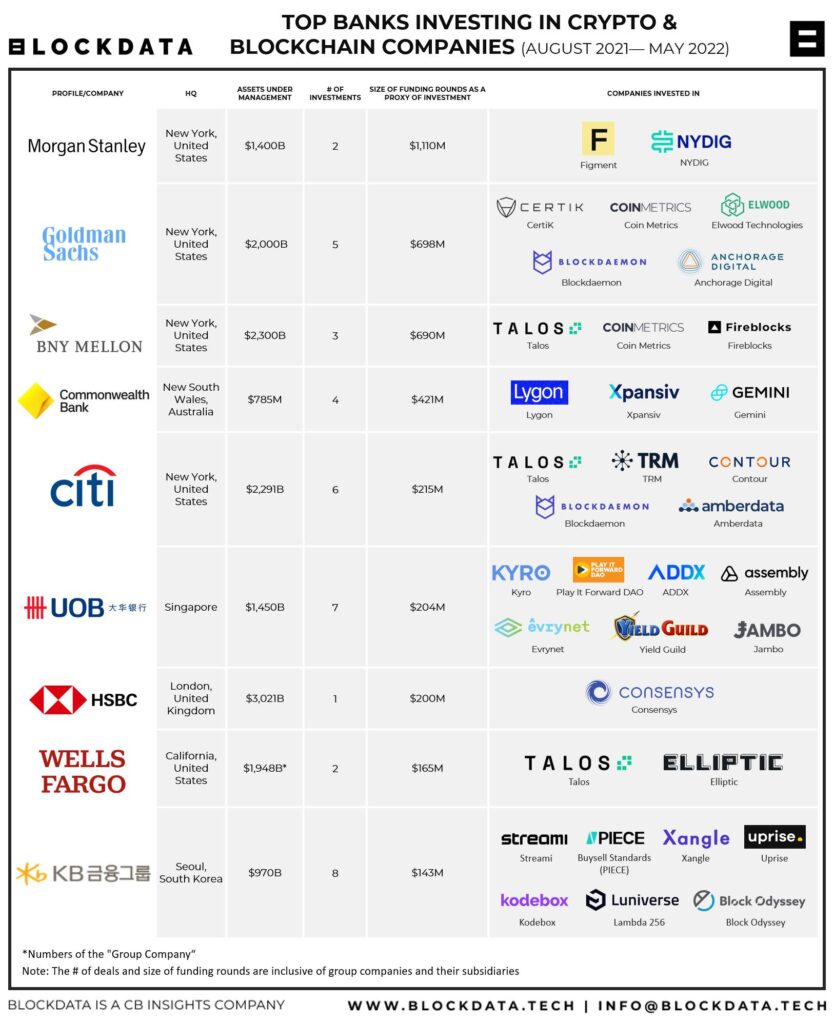
Main Points :
- TradFi giants—Citigroup, Goldman Sachs, JPMorgan Chase, MUFG, and SBI—led 345 blockchain investments from 2020–2024, with 33 mega‑rounds over $100M.
- Global Systemically Important Banks (G‑SIBs) accounted for 106 investments, including 14 mega‑rounds, focusing on trading infrastructure, custody, tokenization, and payments.
- Banks-directed investments exceeded $100 billion globally in blockchain ventures over 10,000 deals.
- 90% of surveyed financial executives expect blockchain/digital assets to exert “significant or massive” impact within three years; 65% of banks are actively exploring custody, stablecoins, and tokenized real-world assets.
- Stablecoin transaction volumes reached $650–700 billion per month in Q1 2025; banks increasingly issue their own stablecoins.
- Tokenization of real‑world assets (RWAs) is projected to exceed $18 trillion by 2033, with a CAGR of ~53%.
- TradFi is prioritizing infrastructural blockchain use cases: programmable payments, digital asset custody, cross‑border settlement, rather than speculative consumer crypto.
1. Major Banks Drive Early-Stage Blockchain Investments
Between 2020 and 2024, traditional financial institutions (TradFi) collectively made 345 investments in blockchain startups, primarily in early-stage funding rounds. Top investors included Citigroup and Goldman Sachs (18 deals each), followed by JPMorgan Chase and Mitsubishi UFJ Financial Group (MUFG) with 15 each.
A significant focus was placed on mega‑rounds—large-scale funding rounds exceeding $100 million. Banks participated in 33 such mega‑rounds, injecting capital into companies specializing in trading infrastructure, tokenization, custody, and payment solutions.
Global Systemically Important Banks (G-SIBs)—those whose failure could pose systemic risk—conducted 106 blockchain-related investments, including 14 mega-rounds. This level of participation underlines TradFi’s long‑term strategic commitment to blockchain infrastructure.
2. Institutional Investment Landscape: Over $100 B in Blockchain Infrastructure
The Ripple‑CB Insights‑UK Centre for Blockchain Technologies report estimates that over $100 billion was invested by banks and traditional institutions in blockchain and digital asset initiatives from 2020 to 2024. This figure spans more than 10,000 global blockchain deals.
The rationale for such elevated investment isn’t speculative. Instead, banks are targeting infrastructure modernization, including:
- Cross‑border payment systems with reduced settlement time and cost
- Digital asset custody for institutions
- Tokenization frameworks for real‑world assets
- Trading and issuer infrastructure on blockchain rails
3. Market Confidence: Blockchain’s Impact Seen as Imminent and Substantial
Ripple’s survey of over 1,800 global finance leaders revealed that over 90% expect blockchain and digital assets to have a “significant or massive” impact on finance within three years. Among banks, 65% are actively exploring digital asset custody, and more than half cite stablecoins and tokenized real‑world assets (RWAs) as key focus areas.
Examples of institutional initiatives include:
- HSBC’s tokenized gold platform
- Goldman Sachs’ blockchain settlement tool (GS DAP)
- SBI’s investment in quantum-resistant digital currency research
Interestingly, consumer-oriented crypto offerings such as trading platforms or wallets remain secondary focus—less than 20% of banks offer those services.
4. Stablecoins & Tokenization: High-Speed Growth Trajectories
Supporting the surge in blockchain infrastructure adoption is the growing demand for real-world applications. According to a Citi report, stablecoin transaction volumes reached $650–700 billion per month in Q1 2025, prompting more banks to issue their own programmable, volatility-resistant stablecoins.
Looking ahead, tokenization is expected to drive industry evolution. Boston Consulting Group, together with Ripple, forecasts that the tokenized RWA market could surpass $18 trillion by 2033, translating to a whopping ~53% CAGR.
5. TradFi’s Infrastructure-First Strategy: Beyond Speculation
Unlike speculative crypto flings, TradFi is methodically integrating blockchain into core operations:
- Cross-border & real-time payments: Platforms like Partior and Liink aim to cut transaction times from days to minutes. These systems are often backed by JP Morgan, Citi, and Standard Chartered.
- Tokenizing assets: Real estate, bonds, equities, and treasuries are transitioning to digital tokens—promising liquidity and fractional ownership.
- Institutional-grade custody & trading: Banks are investing in regulated, secure infrastructures for holding and trading digital assets.
- Compliance tools: Analytics firms such as TRM Labs are being incorporated to monitor AML, fraud, and compliance.
- Digital identity / KYC enhancements: Some banks pilot blockchain-based ID systems to streamline onboarding and privacy, reducing redundant compliance processes.
This strategic shift shows that TradFi aims to shape finance with blockchain, not merely experiment alongside it.
6. Embedded Chart: TradFi Bank Investment Counts by Institution
(Insert the above image near here to visually depict the investment distribution across Citigroup, Goldman Sachs, JPMorgan, MUFG, and SBI.)

Conclusion: Blockchain as the Next-Gen Financial Backbone
In summary, the evidence is clear: traditional finance is actively, strategically, and systematically leveraging blockchain to transform its backbone. From early-stage bets to multi‑billion dollar expenditures on infrastructure, the narrative is not about hype—it’s about integration, scalability, and a future-ready financial architecture.
- TradFi investment has entered a mature, infrastructure-first phase: solid funding to core systems—not speculating on retail crypto.
- Peak adoption signals are popularized by stablecoin volumes and projected tokenization growth.
- Regulatory frameworks and institutional mandates are aligning with blockchain’s practicality and relevance in payments, custody, and real-world asset tokenization.
For entrepreneurs, developers, and crypto-curious professionals: the time is ripe to build or engage in blockchain solutions that align with institutional needs—think programmable payment rails, custody compliance systems, tokenization platforms, or identity frameworks.

